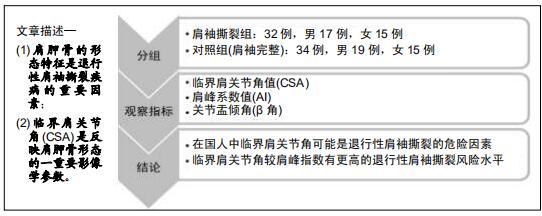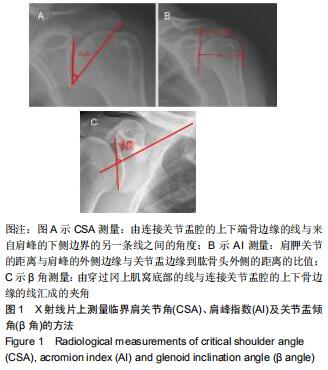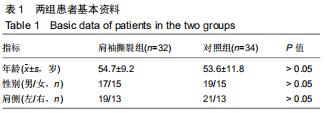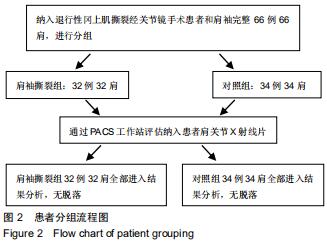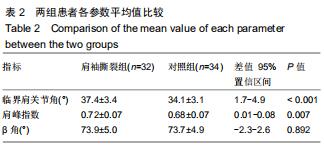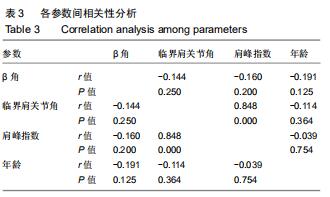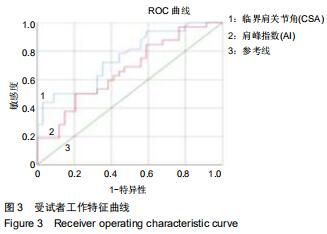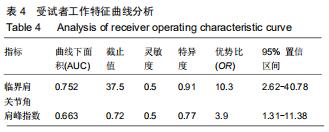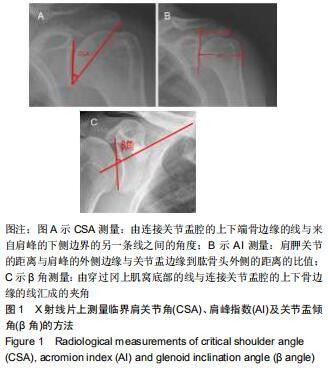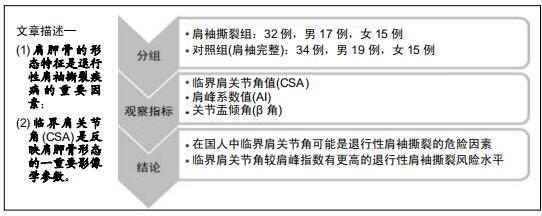|
[1] 朱鸣镝,汤锦波,凌树才,等.肩关节运动时肌肉力臂改变的实验研究[J].中国临床医学,2007,14(2):221-225.
[2] HUEGEL J, WILLIAMS AA, SOSLOWSKY LJ. Rotator cuff biology and biomechanics: a review of normal and pathological conditions. Curr Rheumatol Rep. 2015;17(1): 476.
[3] CHAKRAVARTY K, WEBLEY M. Shoulder joint movement and its relationship to disability in the elderly. J Rheumatol. 1993;20(8):1359-1361.
[4] BAUMGARTEN KM, GERLACH D, GALATZ LM, et al. Cigarette smoking increases the risk for rotator cuff tears. Clin Orthop Relat Res. 2010;468(6):1534-1541.
[5] ABBOUD JA, KIM JS. The effect of hypercholesterolemia on rotator cuff disease.Clin Orthop Relat Res. 2010;468(6): 1493-1497.
[6] HARVIE P, OSTLERE SJ, TEH J, et al. Genetic influences in the aetiology of tears of the rotator cuff.Sibling risk of a full-thickness tear. J Bone Joint Surg Br. 2004;86(5):696-700.
[7] NEER CS 2nd. Anterior acromioplasty for the chronic impingement syndrome inthe shoulder: a preliminary report. J Bone Joint Surg Am. 1972;54(1):41-50
[8] HASHIMOTO T, NOBUHARA K, HAMADA T. Pathologic evidence of degeneration as a primary cause of rotator cuff tear. Clin Orthop Relat Res. 2003;(415):111-120.
[9] SOSLOWSKY LJ, THOMOPOULOS S, ESMAIL A,et al. Rotator cuff tendinosis in an animal model: role of extrinsic and overuse factors. Ann Biomed Eng.2002;30(8):1057-1063.
[10] MOOR BK, BOUAICHA S, ROTHENFLUH DA,et al. Is there an association between the individual anatomy of the scapula and the development of rotator cuff tears or osteoarthritis of the glenohumeral joint?: A radiological study of the critical shoulder angle. Bone Joint J. 2013;95-B(7):935-941.
[11] SUTER T, GERBER POPP A, ZHANG Y, et al. The influence of radiographic viewing perspective and demographics on the critical shoulder angle. J Shoulder Elbow Surg. 2015;24(6): e149-158.
[12] NYFFELER RW, WERNER CM, SUKTHANKAR A, et al. Association of a large lateral extension of the acromion with rotator cuff tears. J Bone Joint Surg Am. 2006;88(4): 800-805.
[13] MAURER A, FUCENTESE SF, PFIRRMANN CW, et al. Assessment of glenoid inclination on routine clinical radiographs and computed tomography examinations of the shoulder. J Shoulder Elbow Surg. 2012;21(8):1096-1103.
[14] MIYAZAKI AN, ITOI E, SANO H, et al. Comparison between the acromion index and rotator cuff tears in the Brazilian and Japanese populations. J Shoulder Elbow Surg. 2011;20(7): 1082-1086.
[15] WATANABE A, ONO Q, NISHIGAMI T, et al. Association between the Critical Shoulder Angle and Rotator Cuff Tears in Japan. Acta Med Okayama. 2018;72(6):547-551.
[16] GOMIDE LC, CARMO TCD, BERGO GHM, et al. Relationship between the critical shoulder angle and the development of rotator cuff lesions: a retrospective epidemiological study. Rev Bras Ortop. 2017;52(4):423-427.
[17] GERBER C, SNEDEKER JG, BAUMGARTNER D, et al. Supraspinatus tendon load during abduction is dependent on the size of the critical shoulder angle: A biomechanical analysis. J Orthop Res. 2014;32(7):952-957.
[18] CABEZAS AF, KREBES K, HUSSEY MM, et al. Morphologic Variability of the Shoulder between the Populations of North American and East Asian. Clin Orthop Surg. 2016;8(3): 280-287.
[19] 陈剑. 肩关节关键角(CSA)与肩袖损伤的相关性研究[A]//浙江省医学会骨科学分会、浙江省医师协会骨科医师分会.2016年浙江省骨科学学术年会论文汇编[C].浙江省医学会骨科学分会、浙江省医师协会骨科医师分会:浙江省科学技术协会,2016:1.
[20] KUM DH, KIM JH, PARK KM, et al. Acromion Index in Korean Population and Its Relationship with Rotator Cuff Tears. Clin Orthop Surg. 2017;9(2):218-222.
[21] BEELER S, HASLER A, GÖTSCHI T, et al. Critical shoulder angle: Acromial coverage is more relevant than glenoid inclination. J Orthop Res. 2019;37(1):205-210.
[22] RHEE SM, KIM JY, KIM JY, et al. The critical shoulder angle: can it be sufficient to reflect the shoulder joint without the humeral head? J Shoulder Elbow Surg. 2019;28(4):731-741.
[23] SINGLETON N, AGIUS L, ANDREWS S. The acromiohumeral centre edge angle: A new radiographic measurement and its association with rotator cuff pathology. J Orthop Surg (Hong Kong). 2017;25(3):2309499017727950.
[24] MELEAN P, LICHTENBERG S, MONTOYA F, et al. The acromial index is not predictive for failed rotator cuff repair. Int Orthop. 2013;37(11):2173-2179.
[25] CHURCHILL RS, BREMS JJ, KOTSCHI H. Glenoid size, inclination, and version: an anatomic study. J Shoulder Elbow Surg. 2001;10(4):327-332.
[26] HUGHES RE, BRYANT CR, HALL JM, et al, Blasier RB. Glenoid inclination is associated with full-thickness rotator cufftears. Clin Orthop Relat Res. 2003;(407):86-91.
[27] KANDEMIR U, ALLAIRE RB, JOLLY JT, et al. The relationship between the orientation of the glenoid and tears of the rotator cuff. J Bone Joint Surg Br. 2006;88(8): 1105-1109.
[28] CHALMERS PN, BECK L, GRANGER E, et al. Superior glenoid inclination and rotator cuff tears. J Shoulder Elbow Surg. 2018;27(8):1444-1450.
[29] DAGGETT M, WERNER B, COLLIN P, et al. Correlation between glenoid inclination and critical shoulder angle: a radiographic and computed tomography study. J Shoulder Elbow Surg. 2015;24(12):1948-1953.
[30] WATANABE A, ONO Q, NISHIGAMI T, et al. Differences in Risk Factors for Rotator Cuff Tears between Elderly Patients and Young Patients. ActaMed Okayama. 2018;72(1):67-72.
[31] LAZARIDES AL, ALENTORN-GELI E, CHOI JH,et al. Rotator cuff tears in young patients: a different disease than rotator cuff tears in elderly patients. J Shoulder Elbow Surg. 2015; 24(11):1834-1843.
|
